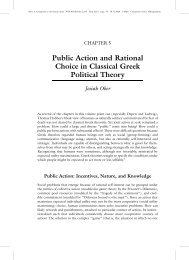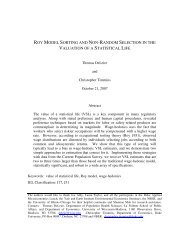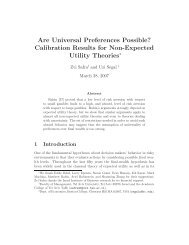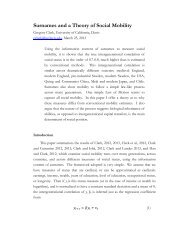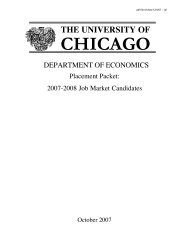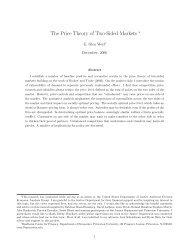CHICAGO - University of Chicago Department of Economics
CHICAGO - University of Chicago Department of Economics
CHICAGO - University of Chicago Department of Economics
Create successful ePaper yourself
Turn your PDF publications into a flip-book with our unique Google optimized e-Paper software.
Santiago Garcia-Verdu<br />
63 E Lake St Apt 802 <strong>Chicago</strong>, IL 60601<br />
Tel. (773) 684-0362 · E-mail: sgarciav@uchicago.edu<br />
http://home.uchicago.edu/~sgarciav/<br />
Education<br />
Fields<br />
Ph.D., <strong>Economics</strong>, <strong>University</strong> <strong>of</strong> <strong>Chicago</strong>, 2009 (expected)<br />
M.E., Financial Engineering, Princeton <strong>University</strong>, 2001<br />
M.A., <strong>Economics</strong> (highest honors), Instituto Tecnológico Autónomo de México (ITAM), 2000<br />
B.Sc., Applied Mathematics (honors), ITAM 1999<br />
Primary: Financial <strong>Economics</strong> and Monetary <strong>Economics</strong><br />
Secondary: Computational <strong>Economics</strong> and Econometrics<br />
Job Market Paper<br />
Equilibrium Yield Curves Under Regime Switching<br />
An unexpected increase in inflation affects yields in two ways. Directly, by decreasing the real component <strong>of</strong> the yields.<br />
Indirectly, by changing the yields as a risk-compensation to the extent it is a prelude <strong>of</strong> bad times. Thus, distinguishing<br />
between transient and long lasting changes in inflation and consumption growth is central to assess their effects on the<br />
yield curve. I develop, estimate and test a consumption-based asset pricing model to obtain yields under different<br />
specifications <strong>of</strong> a state-space model capturing consumption growth and inflation dynamics. To draw a distinction<br />
between the temporality <strong>of</strong> changes, I introduce unobservable components and regimes switching in the state-space<br />
model. Epstein-Zin preferences in turn capture the intertemporal distribution <strong>of</strong> risk. These two are key elements to<br />
introduce variability in the stochastic discount factor. I find that the implied yields with a coefficient <strong>of</strong> risk aversion<br />
between 5 to 30, depending on the exact specification, and a subjective discount factor <strong>of</strong> around 0.998 can capture<br />
central stylized facts including a consistent principal component decomposition and key features on yields' predictability.<br />
Work Experience Banco de México (Central Bank <strong>of</strong> Mexico), Visiting Economist, August 2008-September 2008<br />
Pemex, Deputy Manager, Mexico City, Mexico, July 2002-August 2003<br />
Algorithmics Incorporated, Associate Consultant, Mexico City, Mexico, August 2001-June 2002<br />
Academic Experience ITAM, Lecturer, M.Sc. in Finance, April 2003-June 2003<br />
Center for <strong>Economics</strong> Research (CIE), ITAM, Research and teaching assistant for Pr<strong>of</strong>essor<br />
Alejandro Hernandez Delgado, January 1999-June 2000<br />
Presentations<br />
Awards<br />
Working Papers<br />
Languages<br />
References<br />
Economic Dynamics Working Group, <strong>University</strong> <strong>of</strong> <strong>Chicago</strong> (2006-2008), Instituto<br />
Tecnológico Autónomo de México, (ITAM) (2008), Central Bank <strong>of</strong> Mexico (2008), The 3rd<br />
Mexican Energy Roundtable Business Meeting (2003), N.Y.<br />
Homer and Alice Hanson Jones Fellowship, <strong>University</strong> <strong>of</strong> <strong>Chicago</strong>, 2008-2009, Graduate<br />
Scholarship, Fulbright-Garcia-Robles, Comexus, 2003 –2006, Graduate Scholarship,<br />
CONACYT, Mexico, 2003 – 2008, Graduate Fellowship, Central Bank <strong>of</strong> Mexico, 2003 – 2008,<br />
CONSAR 3rd Best paper on Pension Fund Research, 2006<br />
Real returns and the inflation risk premium, Central Bank <strong>of</strong> Mexico, Working Paper<br />
Computational results for Cash-in-Advance Monetary Models<br />
Monetary Policy and the Term structure <strong>of</strong> interest rates: the case <strong>of</strong> Mexico<br />
Exogenous shocks to income and consumption-risk sharing<br />
Spanish (native), English (pr<strong>of</strong>icient), and basic French and Italian<br />
Pr<strong>of</strong>essor Lars P. Hansen, (chair), (773) 702-8170, l-hansen@uchicago.edu,<br />
<strong>Department</strong> <strong>of</strong> <strong>Economics</strong>, <strong>University</strong> <strong>of</strong> <strong>Chicago</strong><br />
Pr<strong>of</strong>essor Monika Piazzesi, (650) 723-9289, piazzesi@stanford.edu,<br />
<strong>Department</strong> <strong>of</strong> <strong>Economics</strong>, Stanford <strong>University</strong><br />
Pr<strong>of</strong>essor Fernando Alvarez, (773) 702-4412, f-alvarez1@uchicago.edu,<br />
<strong>Department</strong> <strong>of</strong> <strong>Economics</strong>, <strong>University</strong> <strong>of</strong> <strong>Chicago</strong>





